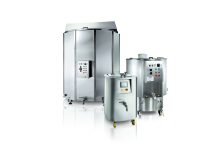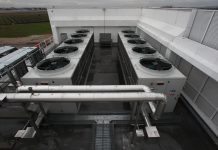 Bakery and confectionery industries, among others, face the challenge of mixing high viscosity fluids (fats, syrups, etc.), mixing fluids containing high volumes of powders (pastes, doughs, covering batters etc.) or mixing together in the same recipe solids of different size, shape and density (ingredients for snack bars as cereal flakes, nuts, dried fruit, chocolate bits etc.). In these circumstances, having the right machinery is just a part of the picture: a deep knowledge or all ingredients is needed in order to decide the mixing equipment, length, temperature etc. and thus to achieve the desired result.
Bakery and confectionery industries, among others, face the challenge of mixing high viscosity fluids (fats, syrups, etc.), mixing fluids containing high volumes of powders (pastes, doughs, covering batters etc.) or mixing together in the same recipe solids of different size, shape and density (ingredients for snack bars as cereal flakes, nuts, dried fruit, chocolate bits etc.). In these circumstances, having the right machinery is just a part of the picture: a deep knowledge or all ingredients is needed in order to decide the mixing equipment, length, temperature etc. and thus to achieve the desired result.
Mixing high viscosity fluids and high solids formulations
Examples of viscous liquids or high solids formulations are chocolate during tempering, nougat, confectionery bases, many bakery doughs, batters, pasta before extrusion, meat pâté, fats, etc. Machinery used for these applications can have a fixed body with moving internal mixer/blender/agitator, or both body and internal parts moving, usually in opposite rotary directions, in order to enhance the mixing effect. Machinery can be vertical or horizontal. Internal mixing parts can be shovels, helixes or turbine for medium-viscosity foods; for high-viscosity application, the internal organ will have high resilience, high diameter in all its parts an low rotation speed. Some mixers consist of a U-shaped horizontal trough and an agitator made up of inner and outer helical ribbons that are pitched to move material axially, in opposing directions, and also radially: this combination promotes fast and thorough blending, with speeds in the range of 300 feet/min (1). High solid formulations of medium viscosity can be prepared in single-shaft rotor/stator mixers or high speed dispersers. For products that undergo a high viscosity phase, multi-agitator and planetary mixing equipment are commonly employed. As viscosity rises, however, even a multi-shaft mixer arrangement will eventually fail to produce sufficient flow: the logical solution is to utilize agitators that move through the batch regardless of product flow; this is what planetary mixers and sigma blade mixers (kneader extruders) do: in a planetary mixer, two or more blades rotate on their own axes as they orbit on a common axis; the agitators continually advance into the batch and contact fresh product all the time. Helical blades allow double planetary mixers to handle viscosities as high as 8 million cP (centipoise) (2).

Final product viscosity is an important parameter: e.g. for batters and coatings, thickness is important to ensure success of coating process (on meat, fish, vegetables and so on) and furthermore to ensure coating remains on the product after cooking. Viscosimeters are used to control this parameter (3). Some more problems arise after production is finished and it is cleaning time. Many mixers/blenders have CIP (cleaning in place) systems that easily remove all food residues. High viscosity fluids or pastes, however, firmly sticks to walls and agitators, making it difficult to remove thoroughly all residues; often a manual intervention using brush, steam, compressed air and/or high pressure water spray is needed. This difficulties can endanger not only microbiological safety but also allergen safety between batches containing different ingredients (cross-contamination risk). A well designed mixer/blender/agitator has no “dead zones” where residues can accumulate, and the interior stainless-steel surfaces must be well-polished, welds included; optional end-plate scrapers may be used for materials that tend to cake or pack. A flush plug discharge valve also reduces stagnant areas in the trough and simplifies cleaning. Some companies produce mixers with completely and easily removable agitators, allowing a high speed product changeover: use of a flat-flange clamshell coupling will allow operators to raise the agitator out of the mixer/blender without moving the end shafts, bearings or seals; this feature adds cost to the machinery purchase, but can save hours between batches, so it is paramount for plants preparing batches with e.g. different allergen profile (4).
Mixing (or not?) heterogeneous solid ingredients
 While for fluids it is possible to reach a complete mixing, this is not the case for solids. The mixing degree that is possible to reach depends on size, shape and density of particles, their tendency to aggregate, moisture content, surface and flowing characteristics of the different materials, mixer efficiency, and so on. Mixing length of time is also an important parameter: heterogeneous materials reach a maximum of mixing uniformity after a certain amount of time, after which prolonging mixing can cause segregation of the different components. There are many different mixers for dry solid foods, some with fixed body (e.g. cochlea mixers) other with moving body (e.g. V-mixers) (5). Some products contain such a mixture of very different ingredient types that trying to mix them is not an option: e.g. instant soups may contain assorted dried vegetables in pieces, noodles or other pasta shapes, dried meat powder and/or other powdered soup bases as bouillon etc. It is impossible to premix such a mixture in an early stage and ensure a consistent proportion off all ingredients in the final pack, since the ingredients will always separate according to their densities and geometries. Such products need a separate filling station for each ingredient, unless two or three ingredients have very similar proprieties (e.g. different vegetable pieces but of the same size and shape, dried meat powder and other powder ingredients). Also mixed solids and liquids, such as canned legumes or vegetables, are similarly filled at two stations: one for the solids and one to top up the fluid portion (6). Properly weighing and accurately delivering the ingredients without manual intervention can result in many process advantages such as fewer mistakes, better accuracy, lower bulk costs, improved product quality and savings in manufacturing costs (especially if handling precious ingredients like probiotics and vitamins).
While for fluids it is possible to reach a complete mixing, this is not the case for solids. The mixing degree that is possible to reach depends on size, shape and density of particles, their tendency to aggregate, moisture content, surface and flowing characteristics of the different materials, mixer efficiency, and so on. Mixing length of time is also an important parameter: heterogeneous materials reach a maximum of mixing uniformity after a certain amount of time, after which prolonging mixing can cause segregation of the different components. There are many different mixers for dry solid foods, some with fixed body (e.g. cochlea mixers) other with moving body (e.g. V-mixers) (5). Some products contain such a mixture of very different ingredient types that trying to mix them is not an option: e.g. instant soups may contain assorted dried vegetables in pieces, noodles or other pasta shapes, dried meat powder and/or other powdered soup bases as bouillon etc. It is impossible to premix such a mixture in an early stage and ensure a consistent proportion off all ingredients in the final pack, since the ingredients will always separate according to their densities and geometries. Such products need a separate filling station for each ingredient, unless two or three ingredients have very similar proprieties (e.g. different vegetable pieces but of the same size and shape, dried meat powder and other powder ingredients). Also mixed solids and liquids, such as canned legumes or vegetables, are similarly filled at two stations: one for the solids and one to top up the fluid portion (6). Properly weighing and accurately delivering the ingredients without manual intervention can result in many process advantages such as fewer mistakes, better accuracy, lower bulk costs, improved product quality and savings in manufacturing costs (especially if handling precious ingredients like probiotics and vitamins).  Weigh belt feeder system combinations for the metering of different components into a mix prior to the packaging line are available: by utilizing a high accuracy feeder mechanism, the enduser can be assured of ingredient cost control and high product quality. These feeders are used for continuous controlled gravimetric feeding of bulk materials, they feature a primary weighbridge and offer an optional secondary weighbridge that provides continuous online auto tare, reducing maintenance and frequency of calibration. In most blend applications, ingredients are delivered to the ingredient bins via bags, boxes, drums or supersacks; once these ingredients are transferred to the product bin, a slide gate at the bin discharge is opened to allow flow of the product to the feeder hopper below. Each individual component is metered upon a predetermined recipe, and discharged to an horizontal conveyor; the product is then sent e.g. to a carousel type packaging machine; in principle it is possible to start and stop each ingredient line. The remaining belt feeders then discharge their ingredients sequentially, in accordance with the programmed sequence of operations, thus creating a layered mix. The number of belt feeders can vary depending upon the number of component in the mix (7).
Weigh belt feeder system combinations for the metering of different components into a mix prior to the packaging line are available: by utilizing a high accuracy feeder mechanism, the enduser can be assured of ingredient cost control and high product quality. These feeders are used for continuous controlled gravimetric feeding of bulk materials, they feature a primary weighbridge and offer an optional secondary weighbridge that provides continuous online auto tare, reducing maintenance and frequency of calibration. In most blend applications, ingredients are delivered to the ingredient bins via bags, boxes, drums or supersacks; once these ingredients are transferred to the product bin, a slide gate at the bin discharge is opened to allow flow of the product to the feeder hopper below. Each individual component is metered upon a predetermined recipe, and discharged to an horizontal conveyor; the product is then sent e.g. to a carousel type packaging machine; in principle it is possible to start and stop each ingredient line. The remaining belt feeders then discharge their ingredients sequentially, in accordance with the programmed sequence of operations, thus creating a layered mix. The number of belt feeders can vary depending upon the number of component in the mix (7).
Bibliografia
2) From Charles Ross & Son Company white paper on mixing high solid formulations
3) www.FoodViscosity.com; www.brookfildengineering.com; www.mpequipment.com
5) Lerici C.R. and Lercker G., Principi di Tecnologie Alimentari. Editrice CLUEB
6) Soroka W., Fundamentals of Packaging Technology. Institute of Packaging Professionals, 4th edition



